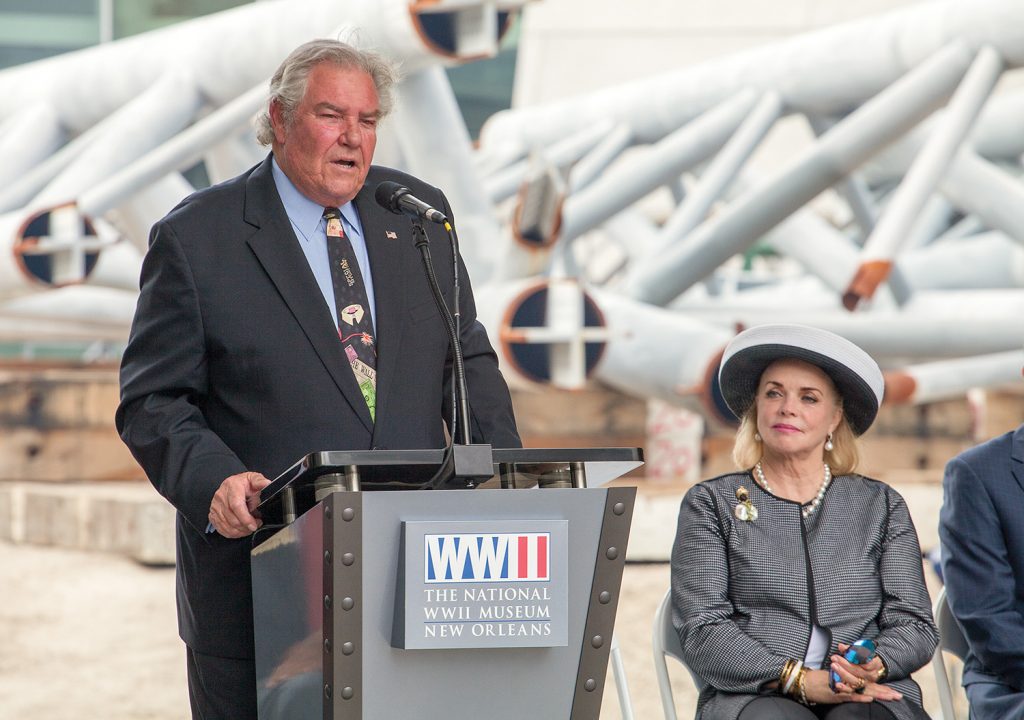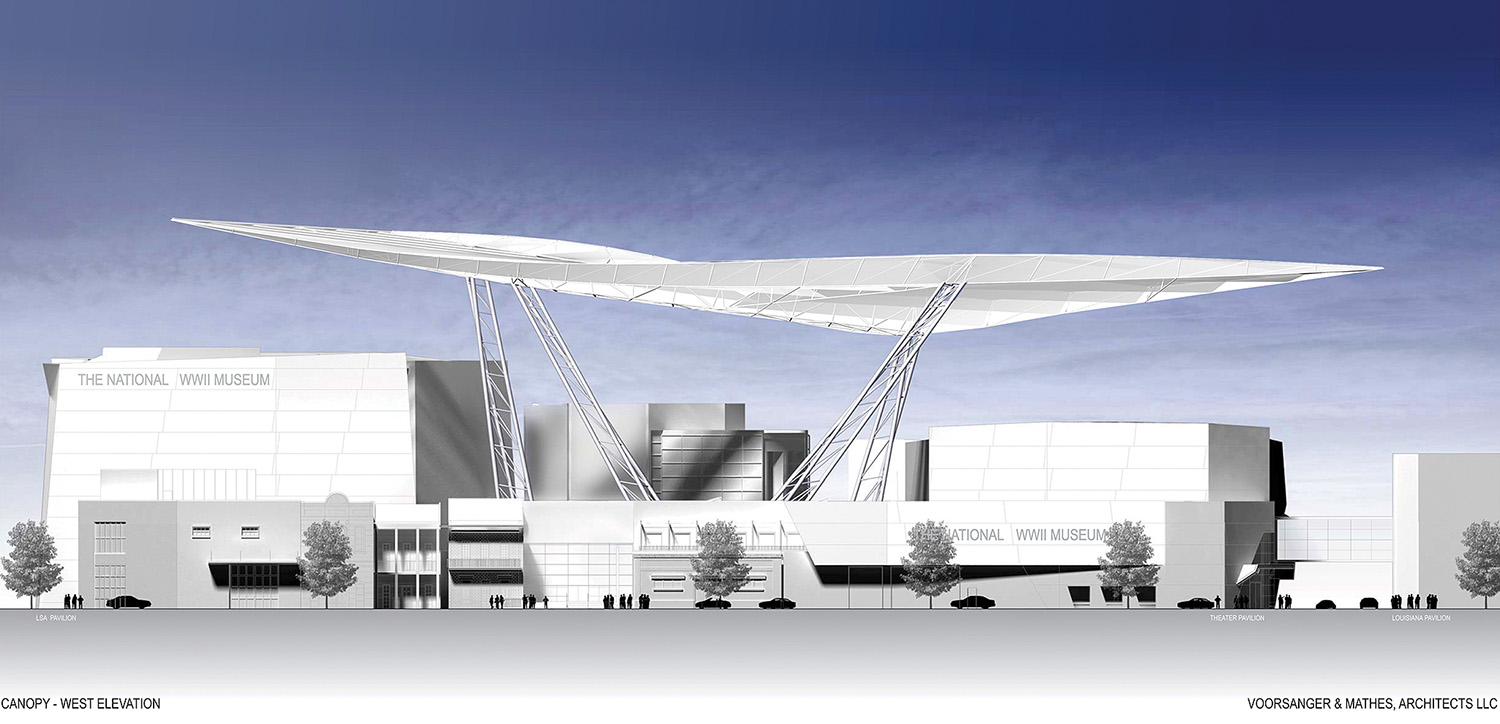The National WWII Museum broke ground March 28 on what museum officials believe will become an iconic landmark, not only for the museum’s campus, but also for the entire city of New Orleans: the Bollinger Canopy of Peace.
The triangular canopy will tower close to 150 feet above the museum campus and will measure 482 feet long and 134 feet wide. Portions of the canopy’s steel support legs were on site for the groundbreaking. The canopy itself will be made of a steel lattice supporting Teflon-coated fiberglass panels. A foundation comprised of more than 1,260 cubic yards of concrete will support the 825-ton structure.
By day, the canopy will shine white as it catches sunlight. By night, a state-of-the-art lighting system will paint the canopy and support legs in a variety of colors and designs.
“A design project of this size and complexity will truly impact our visitors,” National WWII Museum President and CEO Stephen Watson said. “From the moment they arrive on campus, the canopy will grab their attention and set the tone for the rest of their visit. For me, this structure will represent what we were fighting for and, ultimately, the peace that was won.”
The canopy’s total cost is $14 million. Museum officials expect it to be complete by November.
The canopy was made possible by a $20 million donation from Boysie Bollinger and his wife, Joy. Their $20 million gift is the single largest gift ever to the museum from an individual or organization.

Bollinger, a legend in the Louisiana shipbuilding and maritime communities and the former president and CEO of Bollinger Shipyards, joined the museum’s board of trustees in 1995 and was chairman of the board when the museum opened as the D-Day Museum in 2000. Nick Mueller, founding president and CEO of the National WWII Museum and now the museum’s president emeritus, said Bollinger played a critical role in the museum from the start, especially in those lean early days.
“Boysie agreed to join our board back in 1995 at a time when we were almost broke, maybe we were really broke, and things looked bad for us,” Mueller recalled. “That was some five years before we opened the D-Day Museum across the street. His leadership to me and to the board in those years was crucial, not only to our survival, but ultimately to our success.”
Mueller said Bollinger as chairman of the board then became a powerful voice in support of expanding the museum’s mission to become the National WWII Museum.
“Boysie Bollinger has now been with this museum for some 23 years, through good times and bad,” Mueller said. “So it’s now even more fitting to recognize his family name on the Bollinger Canopy of Peace—this signature element, called the iconic element, for the museum, our city, our state and our nation.”
Addressing the crowd, Bollinger expressed his love and appreciation for the mission and message of the National WWII Museum.
“We love this place,” Bollinger said. “We love what it means, what it stands for.”
Bollinger noted that, while it’s been almost 20 years since he was chairman of the board, he has always remained dedicated, engaged and passionate.
“To me, we owe so much to those veterans that gave so much for our freedom,” he said.
Bollinger admitted that, when much of the museum’s campus remained to be built, the board of trustees was reluctant to set aside funds for the canopy project, which is more symbolic than critical to the story of the museum.
“I had a difficult time convincing the board to drive the pilings, because the pilings were driven before this building went up,” Bollinger said. “It wasn’t that much money in the context of how much this building cost, but it was critical if we were going to keep it in the plan. It was critical to have the foundations put in, which were substantial to be able to support this canopy of peace.”
Bollinger’s donation, which he gave in 2015, accomplished two other goals as well. First, it bolstered the museum’s endowment. Bollinger said that component, and encouraging other donors to give to the endowment, is crucial to the sustainability of the campus.
“The endowment was formed when I was chairman, because it was very clear to me that, as we expanded this campus, our earned income was going to be very difficult to sustain the maintenance and operations of a huge campus, basically for the same ticket price you were paying to go across the street,” Bollinger said, referencing the original building of the D-Day Museum.
The endowment, then, underwrites the maintenance and operations cost of the now-sprawling campus.
Bollinger’s donation also resulted in the renaming the museum’s show space, BB’s Stage Door Canteen, a reference to what Bollinger’s grandchildren call him.
Bart Voorsanger, architect for the canopy, also addressed the crowd, saying he’d been asked time and again about the canopy’s ability to withstand tropical winds. He offered a resounding “yes.” The design has been wind tunnel tested and designed to exceed American Society of Civil Engineers safety standards and to stand up to the hurricane-force winds that sometimes visit the Gulf Coast. The same structural engineer who optimized the design for the canopy has previously worked on projects including Mercedes-Benz Stadium in Atlanta, U.S. Bank Stadium in Minneapolis, and the San Francisco-Oakland Bay Bridge.
The National WWII Museum is located at the intersection of Magazine Street and Andrew Higgins Boulevard in New Orleans’ Warehouse District. TripAdvisor has ranked it the No. 2 museum in world, behind only the Metropolitan Museum of Art in New York City.




